Check out my custom vibration dampener
Wilson Clash 98 v2
Review & Playtest
We hope you love this article. Just so you know, TennisCompanion may collect a small share of sales from the links on this page to help keep this site running. Learn more. Disclosure: Wilson gave me this frame to evaluate, but they did not pay me to write this review or influence its contents.
In 2019, Wilson introduced the first generation of the Clash, a completely new model that promised flexible comfort without sacrificing power, a balance that’s hard to strike and uncommon.
For the most part, the racquet delivered on its promises, with a unique feel, unlike any other racquet I’ve playtested. Over the past three years, its mass appeal and popularity have solidified it as a go-to offering for players looking for an arm-friendly frame.
Now, in 2022, the Wilson Clash 98 v2 seeks to build upon the frame’s early success, and I’m excited to share my thoughts. From my thoughts on the new design to its on-court performance, this review will help players decide if it’s worth considering and whether or not to upgrade.
| Popular Clash Models |
| Wilson Clash 98 v2 |
| Wilson Clash 100L v2 |
| Wilson Clash 100 v2 |
| Wilson Clash 100 Pro v2 |
| Wilson Clash 108 v2 |
This review won’t detail the racquet’s specs, technical features, or alternatives to consider. However, if you’d like to explore those, I’d encourage you to check out my Wilson Clash 98 v2 product page.
I’ve also reviewed the Wilson Clash 100 v2, Clash 100 Pro v2, and Clash 108 v2 if you’re interested in learning about those racquets.
Article Contents
Click below to jump to a section
Tap below to jump to a section
Design
Strings & Tension
Performance & Ratings
Groundstrokes
Volleys
Serves
Returns
Summary
Upgrade Advice
New to TennisCompanion?
Create a free account and explore my latest videos below
Design
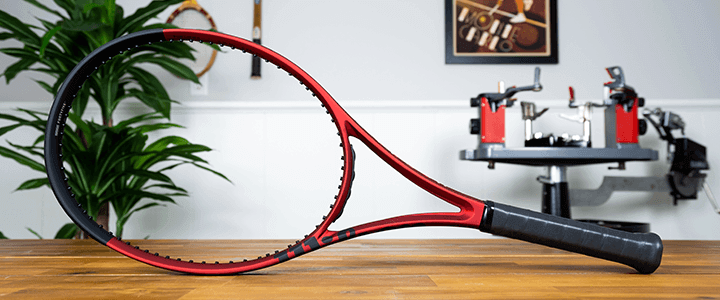
Although a racquet’s cosmetic or paint job doesn’t influence its performance, it’s often one of the most significant changes that a racquet receives each new iteration, influencing buying behavior.
Here’s a look at the first generation of the Wilson Clash 98.

Although the prior generation’s styling didn’t turn me off, it wasn’t my favorite. Not necessarily the colors, but the design template that Wilson was using across their entire line of racquets.
Roughly speaking, the only change from one racquet to the next was the pop of color at the top of the hoop and for the logo, which for the Wilson Clash 98 v1 was a neon infrared.

However, starting with the Wilson Blade v8, Wilson has gone in a different direction with its design selection, and the Wilson Clash v2 is no exception. The latest generation receives a complete overhaul with a deep matte red and black that looks fantastic, despite red not being my favorite.
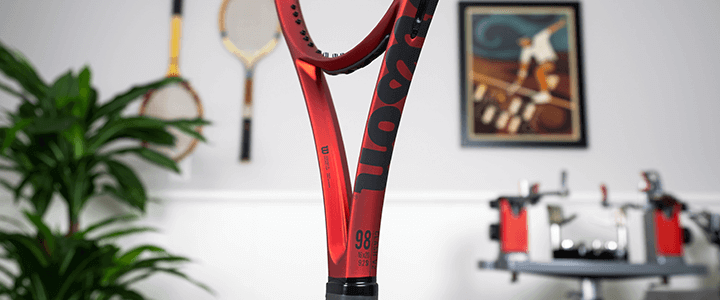
Although the frame’s red color is matte, it has a soft sheen. Like the prior matte finish of the original model, the paint has a subtle rubber-like texture that’s grippy and feels great in hand. Wilson refers to it as an anodized elastic finish.
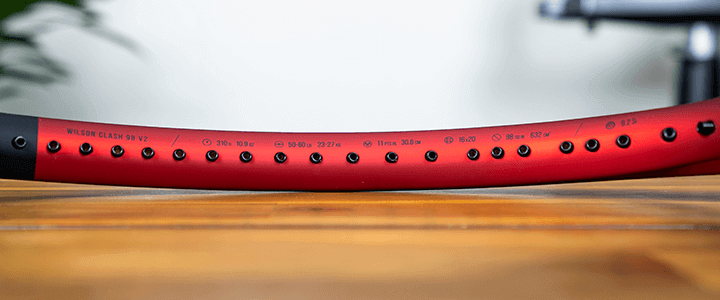
On the inside edge of the racquet’s head, you’ll find the frame’s specs, including its stiffness index, which is a nice touch. Although common, Wilson had removed these from many of their racquets, so I’m glad to see that they’ve reintroduced them.

Additional design elements include the Wilson logo, which wraps one edge of the throat and below it the racquet’s model, head size, string pattern, and stiffness index.

On the opposite side of the throat, a debossed Clash logo gives the frame a bit of texture and unique touch. I think this is my favorite new design touch that you rarely see on other racquets.
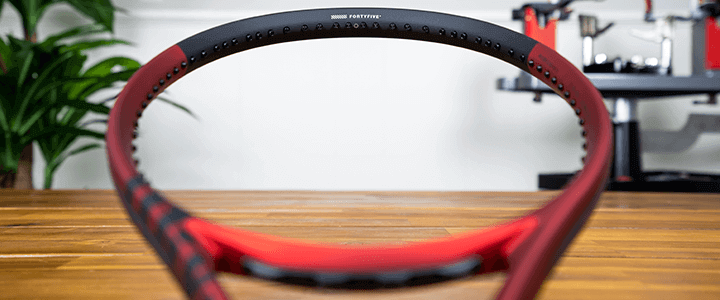
At the top of the frame’s hoop, you’ll find its FortyFive technology called in silver – a nice clean callout.
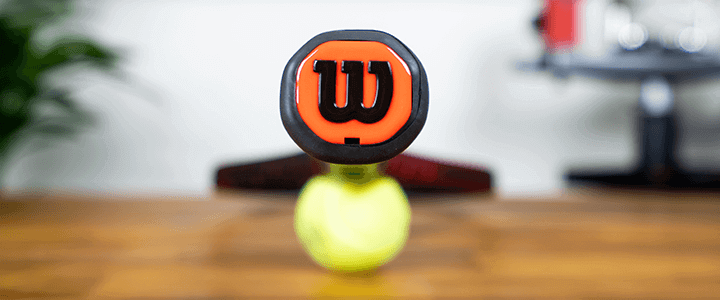
Finally, the racquet features a red butt cap with a black Wilson logo. My only gripe with it is that they didn’t print the grip size on the outside of the cap. However, I did confirm it’s printed on the inside if you pop the trap door off.
Strings & Tension
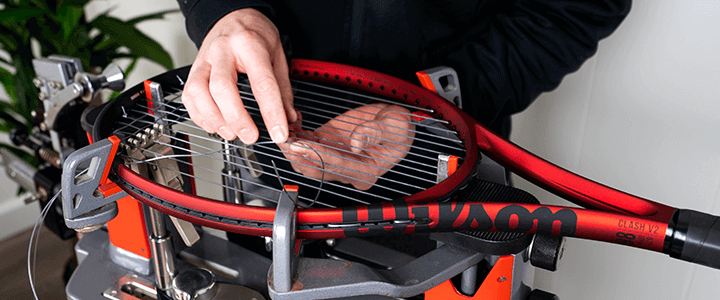
I strung the Wilson Clash 98 v2 with 17 gauge or 1.25 mm Luxilon ALU Power at 55 lbs (24.95 kg) for my playtest, which is dead center between Wilson’s recommended tension of 50 – 60 lbs (22.68- 27.22 kg).
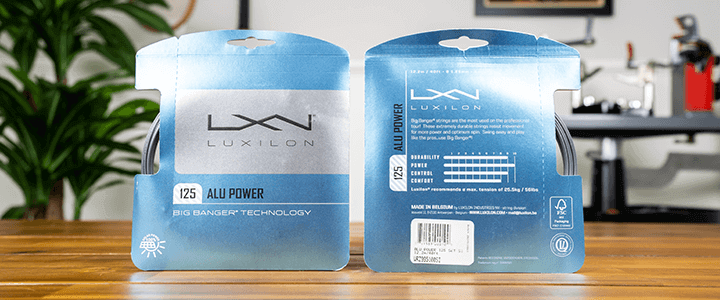
Although the racquet is a comfort-oriented frame, the 98 in² model caters to intermediate and advanced players who value precision. As a result, a stiffer polyester tennis string like ALU Power is an excellent pair for those value control and spin on top of the frame’s comfort.
However, with that said, if comfort is a higher priority for you, then you might opt for a softer poly or a hybrid string setup. A poly with a multifilament or natural gut string would be an excellent option.
Performance & Ratings
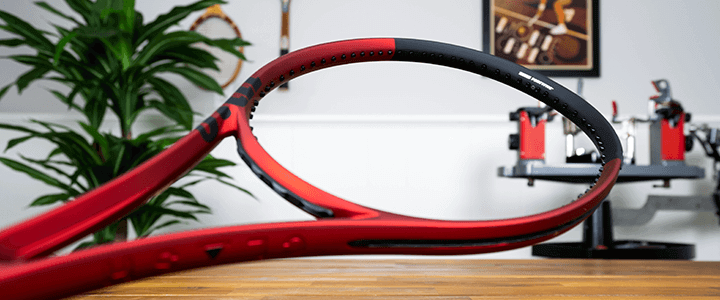
When reading a review or viewing playtest notes from other individuals, I always find it helpful to have as much background info on the player, which helps add color to their comments.
To that end, here’s a bit more about my playtest setup for the Wilson Clash 98 v2. If you’d like, you can read my tennis bio here.
| Main Strings | Luxilon ALU Power (1.25 mm) |
| Cross Strings | Luxilon ALU POwer (1.25 mm) |
| Mains Tension | 55 lbs / 24.95 kg |
| Crosses Tension | 55 lbs / 24.95 kg |
| Forehand Grip | Semi-Western |
| Backhand | Two-handed |
| Grip Size | #3 – 4 3/8 |
| Grip | Wilson Pro Performance |
| Overgrip | Wilson Pro |
| Weight | 165 lbs / 74.84 kg |
| Height | 6’0″ / 1.83m |
I considered twelve different performance criteria to evaluate this racquet and rated its results according to my direct on-court experience.
I describe why I gave the Wilson Clash 98 v2 the above scores in the following sections.
Groundstrokes

I thought the Wilson Clash 98 v2 delivered a well-rounded performance at the baseline. The racquet provided me with a controlled and mostly stable response by combining its 98 in² (632 cm²) head size, a tighter 16×20 string pattern, and moderate 10.9 oz (310 g) unstrung weight.
Although some players will undoubtedly wish this frame had a bit more weight, I think it’s right on target because it feels solid without being too heavy, which lowers the barrier to entry for intermediate players. Plus, it’s easy enough to customize a racquet for a bit of added weight, and the higher-level players who desire it will likely be open to making changes.
I found the Wilson Clash 98 v2 to have moderate power, which will not overwhelm players and kept me in the driver’s seat to rely more on my strength and technique when I wanted to go for bigger shots.
There’s plenty of topspin on tap, especially with quality poly like Alu Power, but I found its tighter 16×20 string pattern to stiffen up the string bed resulting in flatter shots and added depth.

Hitting slice, I thought the racquet delivered above-average performance. The racquet has enough weight to retain stability and change pace, but it’s also maneuverable swinging with one arm.
Reading the racquet’s ultra-low stiffness, I found it to deliver excellent comfort, even while using a poly. I’d encourage players gravitating to this racquet primarily for its comfort to consider a hybrid string set up to maintain a softer overall feel.
Volleys
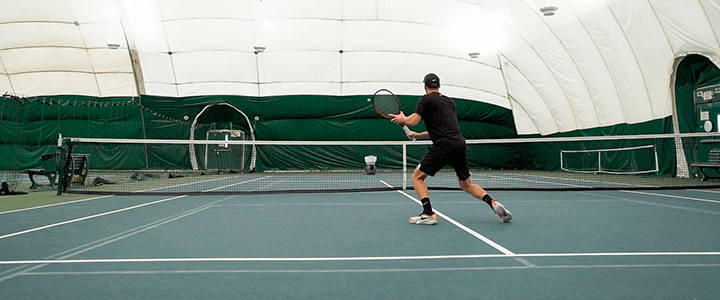
Up at the net, the Wilson Clash 98 v2 is solid. It had enough weight to remain stable in most scenarios and handle extra pace. Combined with its 11 pt HL balance (unstrung), I found I could react quickly.
The smaller head size does require some additional focus and attention, especially for players moving from a 100 in² racquet. However, the added precision may be a worthy tradeoff if you’re up at the net often.
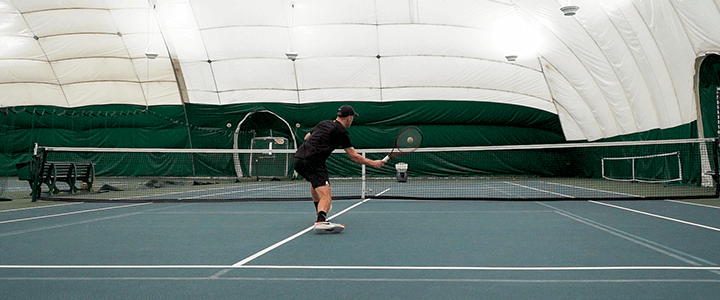
I thought the racquet’s unique comfort-oriented response didn’t offer the best feel or touch up the net. It’s not poor, but it takes some of the feedback out of the picture.
If lack of feel is at all concerning, I’ll encourage you to experiment with a leather replacement grip, which will offer less comfort and help you regain a bit of additional feedback.
Serves

I found the Wilson Clash v2 to emphasize control and precision over power, so if you tend to rely on your racquet to help deliver extra pace on your serve, then that’s something you’ll want to consider.
The smaller head size and tighter 16×20 string pattern doesn’t offer up higher levels of spin, so it takes a bit of extra effort to maximize action on your slice and kick serves. However, with that said, its head light balance ensures the racquet remains plenty snappy, so it’s not that the spin isn’t accessible, but it doesn’t come quite as easy.

Once again, I felt the racquet’s weight was on point for serving. It’s easy enough to get the racquet moving, while its moderate weight helps ensure there’s plenty of weight behind your shot. Again, we’re not talking free power, but the racquet rewards sound technique.
Returns
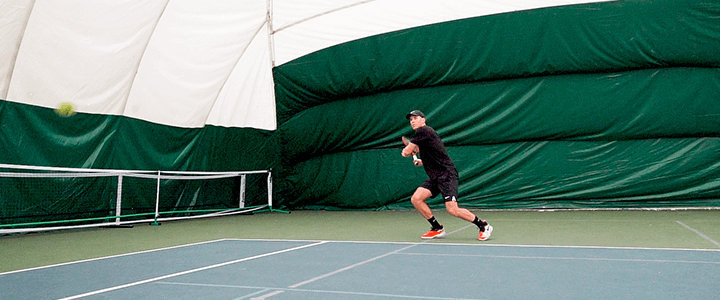
On returns, I thought the Wilson Clash v2’s weight and balance combined to deliver ideal maneuverability to get the racquet into position quickly.
On a heavier serve, the racquet’s stability does suffer slightly, but I don’t expect this will be an issue for most players using it as you have to be facing substantial pace for it to become an issue.

I felt confident stepping into the ball and swinging through with its smaller 98 in² head and tighter string pattern reining in power. Overall, I thought its precision on returns is on-par with what I’d expect from other quality racquets in this spec range.
Summary

The Wilson Clash 98 v2 is an excellent mid-sized tennis racquet that’s well-suited for strong intermediate to advanced players that are less concerned with power and maxing out topspin and prefer to emphasize control and comfort.
Its weight and moderate power make it a solid option for intermediates looking to step into a control-oriented racquet that’s still manageable while improving comfort, which is increasingly a priority.
I would not recommend the Wilson Clash 98 v2 for beginners or those transitioning to their first intermediate performance racquet. Its smaller head size and weight will likely be premature, resulting in less power and margin for error and ultimately unnecessary frustration.
| Popular Clash Models |
| Wilson Clash 98 v2 |
| Wilson Clash 100L v2 |
| Wilson Clash 100 v2 |
| Wilson Clash 100 Pro v2 |
| Wilson Clash 108 v2 |
Upgrade Advice

There’s a lot to like about the Wilson Clash 98 v2, but the upgrade won’t be ideal for everyone.
Who Should Upgrade
My recommendation would be to encourage players who use the first generation and would like a bit of extra control and precision to consider the upgrade.
If you’ve found success and enjoyed playing with the Wilson Clash 98 v1 over the past few years and your skills have improved along the way, then the second generation may help you tighten up your game a bit.
The racquet’s tighter string pattern results in a bit less spin and power, added control, and a slightly stiffer feel.
At my level and considering my preferences, I would upgrade to the latest model because I prefer the modifications, and I expect the more experienced players using the original Clash 98 will also enjoy them.
However, please don’t take my word for it alone. I’d encourage you to use my thoughts on the racquet as a basis for whether or not to spend your time and money demoing the Wilson Clash 98 v2. If you do, check out Wilson’s demo program to experience the differences firsthand.
Who Shouldn’t Upgrade
Whenever a new model of racquet releases, it’s tempting to upgrade regardless of the changes. However, if you don’t have any complaints about the original model and you’re hitting well with it, then there’s no reason to mess with a good thing.
The Wilson Clash 98 v2’s tighter string pattern has some pros, but it will be a detractor for some. The first generation is still an excellent racquet, and I’m confident there will be a core group of individuals who prefer it.
With that said, I don’t think the latest model is such a dramatic departure from the original that the changes would turn existing users off when hitting with it. If my comments don’t sway you one way or another, then there’s nothing wrong with picking up the latest model, even if it’s because you like the new design.
Wrapping Up

When Wilson first launched the Clash in 2019, I was a bit skeptical. In concept, delivering a racquet that struck a balance between optimal flex for comfort while retaining extra power seemed like a tall order.
However, while not perfect, Wilson’s execution of the idea is strong, and it’s a line of racquets I regularly recommend, especially for those struggling with arm discomfort.
Due to its popularity, it’s not surprising they’ve continued to offer and refine the Clash, but I’m also glad they did.
With the release of the second generation, Wilson sends a clear message that the Clash isn’t purely an experimental project. Instead, it’s a core part of their performance racquet offerings that I expect will only continue to gain traction as more players try it out.
Of course, it’s not for everyone, but if you give it a try, I’m pretty confident you’ll know relatively quickly if it’s for you.
Play Better Tennis
Improve your game alongside our community of tennis players
Why join?
Discussion Boards
Join the conversation with other members of the community.
5 Point Friday
Read our weekly recap of the 5 most interesting things we dig up in tennis.



Leave a Reply
Want to join the discussion?Feel free to contribute!